Celine New Bond Street: a carnival of materials, furniture and art
The French maison opens Celine New Bond Street, an art-filled flagship store in central London. Commissioned artworks by Nika Neelova and Leilah Babirye and a distinctively contemporary material palette contrast with the listed Edwardian building, reflecting artistic director Hedi Slimane’s vision of exacting opulence
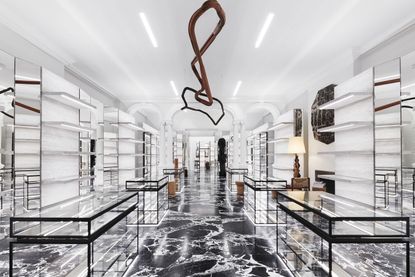
The ground floor space of Celine New Bond Street, which has been designed to reflect French elegance and classical luxury. Nika Neelova’s sculptures, Lemniscate XI and Lemniscate XIV, made from reclaimed bannister handrails, are suspended from the ceiling. Asger Dybvad Larsen’s Untitled is pictured on the right hand wall, and Leilah Babirye’s sculpture Najunga from the Kuchu Ngaali (Crested Crane) Clan can be seen in the background
Approach the Baroque-style façade at Celine New Bond Street, the maison’s new London flagship, and you will be greeted not by handbags, shoes and clothes, but by statement of material integrity and modernist rigour: sitting in a street-facing window is a sculpture by the artist Marie Lund, which positions a copper wing against blocks of clay. Perfectly disarming and seductive, this is a portal into Celine artistic director Hedi Slimane’s arena of exacting opulence.
With its veiny marble floors, folding mirrors and glowing shelves, the store – located at 40 New Bond Street – channels a brutalist neo-classical ambience somewhere between a 15th-century Dutch still life and the luminous hotel suite in 2001: A Space Odyssey. It is a sculptural space, flooded with stone, granite, marble, reclaimed oak, concrete, polished stainless steel and brass. A carnival of materials, furniture and artworks that is elemental and awesome.
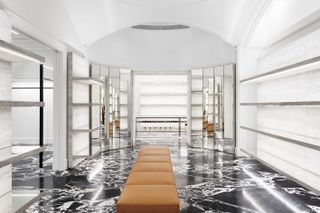
The shoe hall on ground level is set in a lozenge-shaped room, fitted with mirror panels that fragment the displays into new formations
Step into Celine New Bond Street, the French maison’s art-filled central London flagship
Slimane’s intention was to interact with the Grade II-listed Edwardian building in two unique ways. The 345 sq m ground floor is devoted to women, formulated around the aura of French elegance and classical luxury. An octagonal room – originally designed in the manner of an Italian grotto with panels of fine shell work – is now dedicated to the Celine Haute Parfumerie collection. Long shelves and racks float in space. Two of the London-based artist Nika Neelova’s wooden handrail sculptures are suspended from the ceiling. ‘This commission was an interesting way of letting go of something and allowing it to acquire its own life and place in the world. One that is outside of institutions and galleries,’ she says.
Mirrored panels lining the walls fragment all of the works on display into new formations. ‘It almost creates this infinite loop wherever you look, with all of the artists coming together. I'm very interested in this hybrid model where disciplines start to cross over and boundaries become blurred,’ Neelova says. ‘Looking at references from outside the fashion world within the context of a shop is a beautiful way for things to evolve. This feels like the perfect art exhibition.’
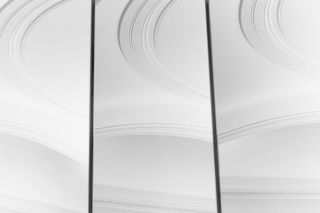
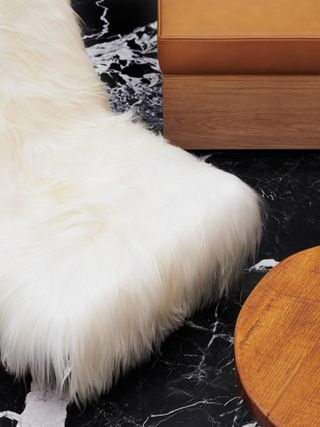
Top: Edwardian ceiling mouldings as seen in the mirrored panels. Above: a fur-upholstered chair brings an unexpected dash of warmth to the ground floor space
The vast floor plan of 466 sq m is punctuated by numerous pieces that form part of the Celine Art Project, which invites contemporary artists to make works specifically for stores around the world. Slink into the basement men’s department and you are greeted by a polished cast bronze bell by the artist Davina Semo – which you are invited to toll – hovering over a nook of eclectic wooden stools, chairs and books on Auguste Rodin, Charlotte Perriand and Otto Dix. Here the walls are finished in smooth white, the floor a fine smog-hued concrete.
The artworks create a unique tension between what is public and private space, exhibition and exhibitor, material and meaning. This reimagining of form, place and value is what appealed to the New York-based sculptor Leilah Babirye, whose 2.7m wooden totem stands on the ground floor in front of a mirrored concertina. It signals a change in the space from one room to the next. ‘In this context, I feel as if the piece captures a lot of people – it opens a lot of the dialogue that I am trying to discuss in the work itself,’ she says. ‘I've never done anything for a store or public space, so I’m interested to know how people react and relate to it. I didn’t know about Celine before because I'm not a fashion person. I am an artist.’
Wallpaper* Newsletter
Receive our daily digest of inspiration, escapism and design stories from around the world direct to your inbox.
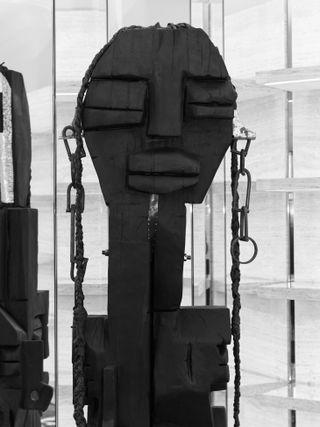
Leilah Babirye, Najunga from the Kuchu Ngaali (Crested Crane) Clan, a 2.7m wooden totem sited on the ground floor of Celine New Bond Street. Courtesy Gordon Robichaux, New York and Stephen Friedman Gallery, London
Through her large-scale ceramic pieces, wooden sculptures, masks, drawings and paintings, Babirye examines clan hierarchy in the kingdom of Buganda, a Bantu enclave within her native Uganda. Her use of found materials is a way of grappling with LGBTQ+ history and ‘the sense of us being called trash’. Titled Najunga from the Kuchu Ngaali (Crested Crane) Clan, the piece is an unflinching tower of dark wood, wax, glue, acrylic, bolts, washers, nails, aluminium, plaited bicycle tyre inner tubes and welded metal. She was commissioned to make the piece in July. ‘That was also very hard for me because I don't work like that – with somebody telling me they want something that looks like another piece I have made,’ Babiyre says. ‘I don’t have sketches. I never know what I'm going to make the next time I am carving or whether I will find the same materials. I just look at the material. The material drives me to do whatever happens.’
RELATED STORY
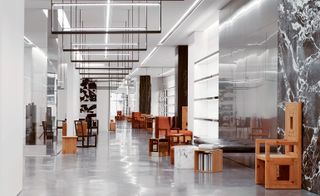
This matter of materials is what is most striking in Slimane’s curatorial act. Both Babirye and Neelova’s pieces are embedded with veiled meaning, their material provenance just as important as their conceptual heft. ‘I have a pile of things that I've collected from all over the place, even from scrap yards. It’s surprising to see the difference in what people throw away here in the US,’ Babirye says. ‘Where I am from, it’s hard to find things because people use stuff. So when somebody from home sees my work with spoons, forks, knives, they ask, “Do you buy them?” and I have to explain that I find them on the street.’
Neelova’s Lemniscate XI and Lemniscate XIV are made from reclaimed bannister handrails which she reassembles into sweeping orchestral objects. They resonate with Slimane’s preoccupation with presenting us with something we think we have seen before – denim jeans, varsity jackets, tailored skirts – yet under his direction feel curiously new.
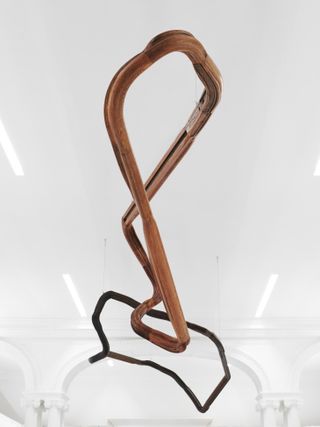
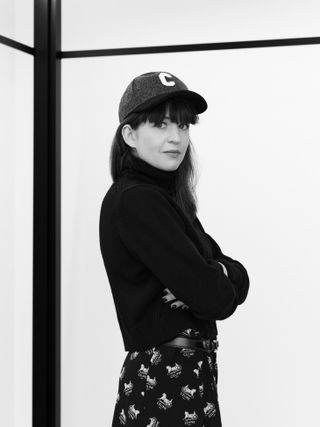
Top: Nika Neelova’s sculptures, Lemniscate XI and Lemniscate XIV, which are made from reclaimed bannister handrails and suspended from the ceiling of Celine New Bond Street. Courtesy of the artist. Above: Neelova, photographed at Celine New Bond Street on 1 November 2021
‘I think in that sense, there is a contrast to the works on show because my pieces are based on rescued and repurposed architectural fragments, but I've chosen the handrail because it's something that is moulded specifically to fit in the palm of the hand. It is something designed based on human proportion and it choreographs the body through space. I think there is a nice crossover in the sense that fashion is so much built around the human body and human proportions,’ Neelova says. ‘I had read somewhere that over time, wooden banisters collect microscopic bits of skin. And so to me these pieces also carry the memories of all of the people who have interacted with them. They carry the DNA of hundreds and hundreds of people.’
Dealing with the human body is fashion’s modus operandi. Positioned in one of the menswear fitting rooms is an oil painting dated 1670 of a young man dressed in steel body armour and white silk sash. Entitled Portrait of Maximilien de Bethune Duc de Sully and of the Flemish school, it curiously aligns with Slimane’s own ongoing photographic ode to youth and beauty. It adds another layer to the shop as a space for mortal contemplation.
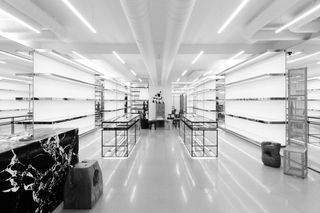
The basement men's department is likewise populated with artworks, including, in the centre, 2 Holes by American sculptor Mel Kendrick. Courtesy of the artist and David Nolan Gallery
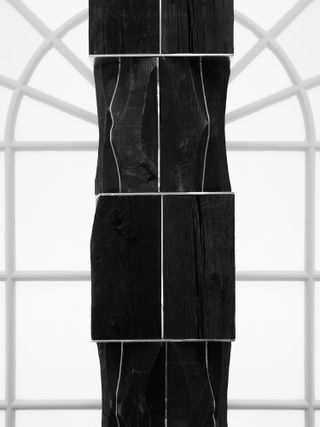
Canadian sculptor Lukas Geronimas' Column, an artwork commissioned for Celine's New Bond Street space, positioned in front of an arched window on the ground level. Courtesy of the artist and Jeremy Jansen
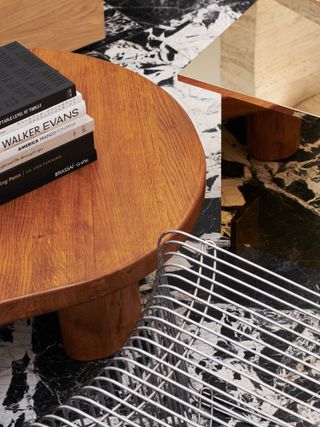
The flagship store's material palette includes natural wood, polished brass, stainless steel and veiny marble
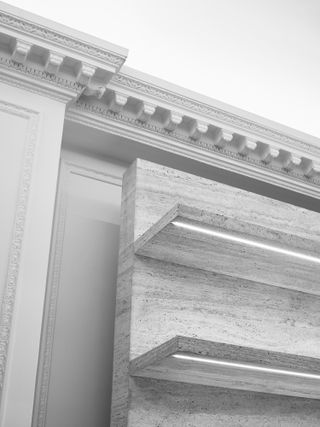
Geometric travertine shelving with recessed strip lighting contrast with the original Edwardian mouldings
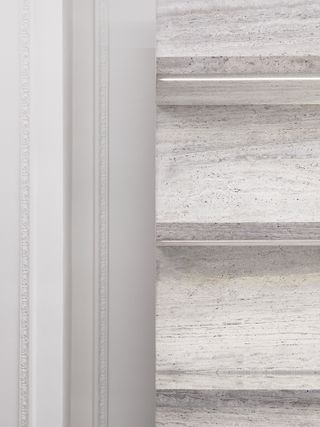
Historic features and contemporary additions co-exist in harmony throughout the space
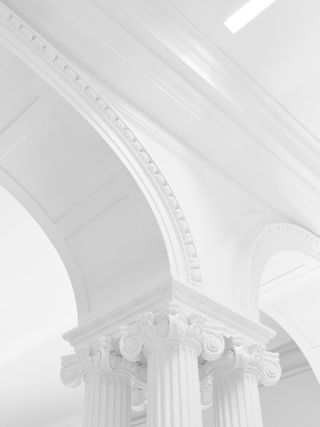
Original architectural features within the ground level space
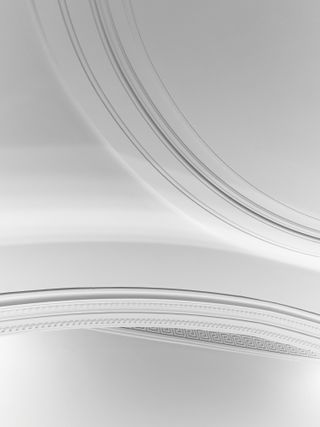
Original architectural features within the ground level space
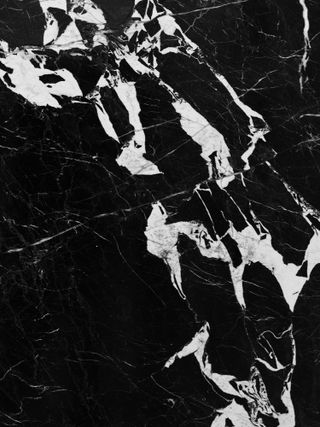
A detail of the marble flooring on the ground level
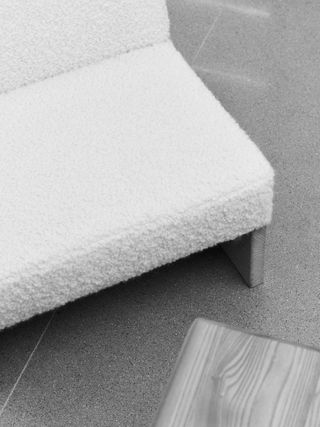
Woollen upholstery contrasts with the grey concrete floor in the basement space
INFORMATION
40 New Bond Street, London W1
celine.com
London based writer Dal Chodha is editor-in-chief of Archivist Addendum — a publishing project that explores the gap between fashion editorial and academe. He writes for various international titles and journals on fashion, art and culture and is a contributing editor at Wallpaper*. Chodha has been working in academic institutions for more than a decade and is Stage 1 Leader of the BA Fashion Communication and Promotion course at Central Saint Martins. In 2020 he published his first book SHOW NOTES, an original hybrid of journalism, poetry and provocation.
-
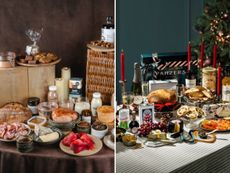 This year's best luxury Christmas hampers for festive celebrations
This year's best luxury Christmas hampers for festive celebrationsThe best Christmas hampers are a classic gift for a reason: everyone loves receiving a basket of beautifully curated pantry fillers just in time for the festivities. Here are our top picks for 2024
By Rosie Conroy Published
-
 17 questions for Michael Kiwanuka
17 questions for Michael KiwanukaAs he prepares to release his fourth album 'Small Changes', we ask Michael Kiwanuka some of life's important questions
By Charlotte Gunn Published
-
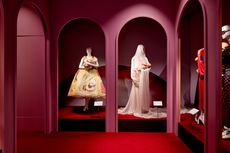 Inside ‘M&OTHERS’, the experimental exhibition dissecting the relationship between fashion and motherhood
Inside ‘M&OTHERS’, the experimental exhibition dissecting the relationship between fashion and motherhoodA new exhibition at Modemuseum Hasselt, Belgium explores the rarely examined link between fashion and motherhood, in all its forms
By Dal Chodha Published
-
 Hedi Slimane to leave Celine after seven years; Michael Rider named as successor
Hedi Slimane to leave Celine after seven years; Michael Rider named as successorHedi Slimane will leave Celine after a seven-year tenure as artistic, creative and image director across fashion, beauty and lifestyle at the French couture house, with Michael Rider – an alumnus of Phoebe Philo’s Celine – named as his successor
By Jack Moss Last updated
-
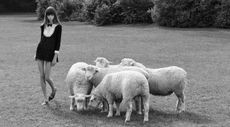 Hedi Slimane’s latest Celine collection is an homage to the leading ladies of 1960s France: watch the film
Hedi Slimane’s latest Celine collection is an homage to the leading ladies of 1960s France: watch the filmInspired by listening to The Velvet Underground and Nico while re-reading Françoise Sagan, Hedi Slimane pays ode to legendary French it-girls like Sagan, Françoise Hardy and Juliette Gréco with a collection rooted in the liberatory spirit of the 1960s
By Jack Moss Published
-
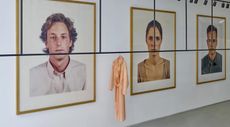 A guide to the best fashion stores London has to offer
A guide to the best fashion stores London has to offerWallpaper* picks the must-visit London fashion stores – from big-name boutiques and classic department stores to the best in vintage, alongside the sleek and experimental
By Jack Moss Last updated
-
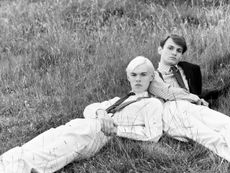 Hedi Slimane takes Celine to Norfolk for ‘Anglomania’ menswear collection: watch the film
Hedi Slimane takes Celine to Norfolk for ‘Anglomania’ menswear collection: watch the filmInspired by Evelyn Waugh’s ‘Bright Young Things’, Hedi Slimane’s latest Celine menswear collection is captured by the designer in a romantic short film set at the Palladian Holkham Hall on England’s Norfolk coastline
By Jack Moss Published
-
 Why solid soap is the most pleasurable object to bathe with
Why solid soap is the most pleasurable object to bathe withSolid soap provides a tactile bathing experience like no other. Hannah Tindle explores why in the September 2024 Style Issue of Wallpaper*, with soaps by Chanel, Celine, Diptyque, and more, photographed by Sophie Gladstone
By Hannah Tindle Published
-
 ’What is the life of a woman?’: Nadège Vanhée on a decade of womenswear at Hermès
’What is the life of a woman?’: Nadège Vanhée on a decade of womenswear at HermèsFor the past ten years, Nadège Vanhée, head of womenswear at Hermès, has steered the French maison on a quietly rebellious path, exploring notions of contemplation, liberation and sensuality. Speaking to fashion features editor Jack Moss, she unpacks her evolution
By Jack Moss Published
-
 Wallpaper* September 2024, The Style Issue, is on newsstands now: discover the looks of the season
Wallpaper* September 2024, The Style Issue, is on newsstands now: discover the looks of the seasonWallpaper* September 2024, The Style Issue, heralds sensual dressing for the season ahead. Hear from Dior’s Kim Jones, Hermès’ Nadège Vanhée, and tour Karl Lagerfeld’s bookshop
By Bill Prince Published
-
 Celine Beauté by Hedi Slimane: ‘Rouge Triomphe’ is the quintessential red lipstick (and it’s now available worldwide)
Celine Beauté by Hedi Slimane: ‘Rouge Triomphe’ is the quintessential red lipstick (and it’s now available worldwide)Hedi Slimane’s Celine Beauté has officially arrived, with its debut ‘Rouge Triomphe’ lipstick available to shop globally in-store and online
By Hannah Tindle Last updated